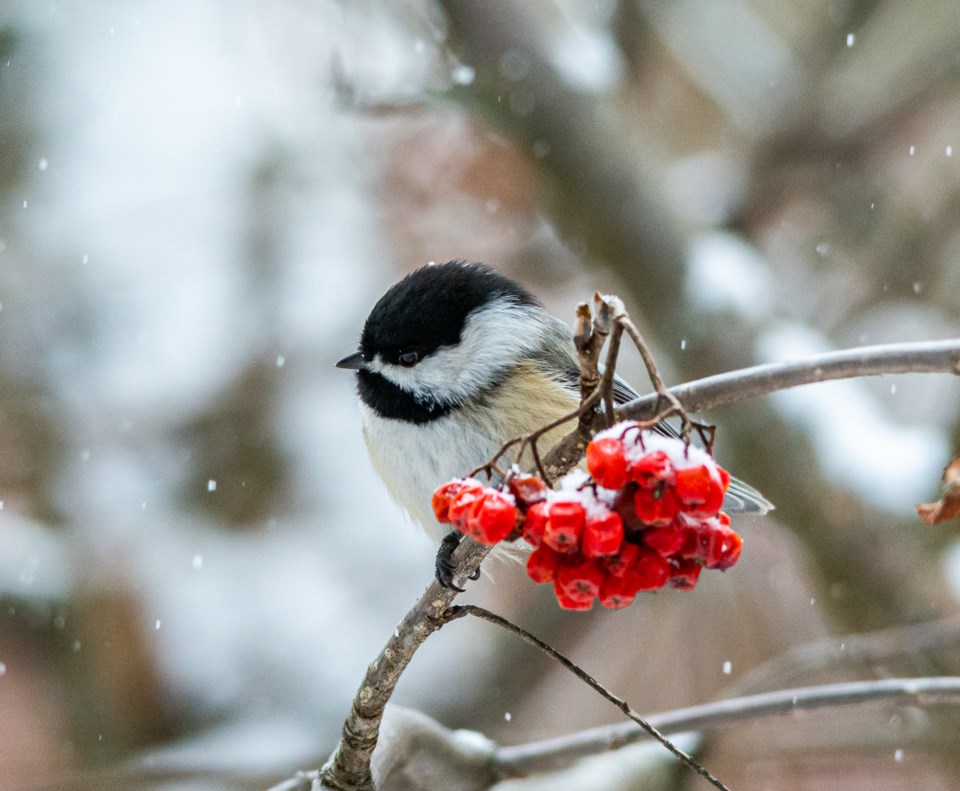When the wind and snow of winter blow by our windows and the stinging cold sets in, it can be hard to imagine how Alberta’s wild animals manage to survive until spring. After all, not just big, tough-looking animals like moose and bison, but cute little chickadees and nuthatches are also out there braving the cold snaps. People get concerned about the well-being of wildlife during cold periods, but our native species are tougher than they look, and have ways of making it through.
Having a permanent coat of fur or feathers is a big help. As anyone with a down parka can attest, feathers are great at trapping heat. This keeps our resident birds warm enough to get by. Some birds, like the Great Grey Owl, have such dense coats that even the coldest temperatures don’t seem to faze them. Songbirds like chickadees and waxwings puff out their feathers on cold days, making them look like fuzzy little balls and keeping their scaly feet covered while perching.
The fur of some mammals grows thicker during the cold months for extra warmth. Afterwards it falls out in clumps, giving animals like elk and sheep a ragged, unhealthy look, much to the concern of springtime visitors to the Rockies. Moose, plagued by blood-sucking winter ticks, will occasionally rub off fur while trying to rid themselves of the parasites. These ‘ghost moose’, as they’re known, can make it through the winter as long as there’s enough to eat.
Food is a crucial aspect of winter survival. Birds and mammals are warm blooded, meaning they produce their own heat to keep a consistent body temperature. This heat is fueled by the food they take in, meaning warm blooded animals either need to pack on the calories from spring through fall or keep up a consistent intake over the winter.
Squirrels are well known for their habit of making reserve food stashes. Piles of spruce cone seeds at the base of a tree left behind by squirrels, known as middens, are a common sight in Alberta’s forests. Seed-eating birds like chickadees and nuthatches cache seeds in the nooks and crannies of tree bark, and sections of chickadees brains will actually swell late in the year to help them remember where their emergency food stashes are. Songbirds are noticeably full of pep in the winter, constantly zipping around in search of high-calorie seeds. Woodpeckers tirelessly hunt for beetle larvae hiding in tree bark, and falcons stalk feeders and open water for prey. Since birds can’t store adequate fat as fuel for the winter, those that stick around need to work extra hard to get enough to eat.
Large herbivores will eat buds and bark in winter to scrape by but going into the season already healthy and well-fed is critical. Weak individuals, in turn, provide important food for wolves and the scavengers that follow them. Clever opportunists like magpies, ravens, and coyotes take advantage of whatever they can get.
Animals know how to modify their behaviours to deal with winter conditions too. Seeking sheltered areas and huddling together during cold snaps can make all the difference. The south-facing sides of tall buildings can warm up significantly during the day, providing urban birds with some relief from the cold. During harsh winter nights, some small mammals and birds will enter a state of torpor, a bit like short-term hibernation where the metabolism and brain function slow down until it’s warm enough to go look for food again.
The ancestors of Alberta’s native wildlife were survivors of the Ice Age, and their descendants have made it through tens of thousands of winters ever since. While stark conditions claim a few individuals each year, this is the reality of nature. The best thing we can do is leave wildlife alone, not remove their natural sources of food and shelter, and admire the adaptability that sees them through.
Nick Carter is a writer, photographer and naturalist from Edmonton. See more at naturenickphotography.com



